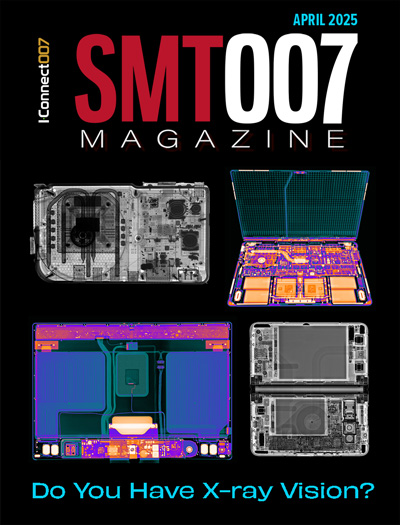-

- News
- Books
Featured Books
- smt007 Magazine
Latest Issues
Current Issue
Do You Have X-ray Vision?
Has X-ray’s time finally come in electronics manufacturing? Join us in this issue of SMT007 Magazine, where we answer this question and others to bring more efficiency to your bottom line.

IPC APEX EXPO 2025: A Preview
It’s that time again. If you’re going to Anaheim for IPC APEX EXPO 2025, we’ll see you there. In the meantime, consider this issue of SMT007 Magazine to be your golden ticket to planning the show.

Technical Resources
Key industry organizations–all with knowledge sharing as a part of their mission–share their technical repositories in this issue of SMT007 Magazine. Where can you find information critical to your work? Odds are, right here.
- Articles
- Columns
Search Console
- Links
- Media kit
||| MENU - smt007 Magazine
Controlling Chain Conformations to Enhance Electronic Devices
December 2, 2016 | Pennsylvania State UniversityEstimated reading time: 3 minutes
Controlling the way fluorinated polymer chains twist and turn may enable fast and flexible electrical circuits, according to collaborative research conducted at Penn State. The findings may offer substantial impact on the development of new polymer-type materials used in flexible electronic applications.
Organic thin film transistors (OTFTs), which integrate organic semiconducting compounds in electronic components, have the potential to revolutionize the field of flexible electronics by generating bendable and foldable devices that act as electronic circuits. OTFTs are the building blocks of more complicated circuits and serve as the "on" and "off" switches between various electronic states. They are comprised of multiple layers, including a dielectric layer — which functions as an insulator — responsible for inducing charge.
"Our work aims to introduce new, more stable polymers into electrical circuits without negatively impacting performance," said Enrique Gomez, associate professor of chemical engineering, Penn State. "By controlling the way that polymer chains twist and bend at a molecular level in OTFTs, we have found that we are able to break the universal relationship between charge mobility of the semiconductor and charge storage capacity of the dielectric layer, providing a basis to create fast and reliable circuits from organic materials."
Controlling the order and arrangement of polymer chains along the semiconductor interface is the key in breaking the relationship, according to research published in Advanced Materials.
Polymers are capable of storing large amounts of electrical energy in the insulator, however, it is known that electrical energy slows as it travels through semiconducting materials. The hope is that new findings about the inverse relationship will lead to the development of fast organic devices with the capacity to revolutionize the flexible electronics industry.
Controlled arrangement of polymers is possible using new chemistries developed at Penn State that introduce cross-linkable polymers into high-charge capacity chains.
Gomez explained, "Polymers can easily be imagined as long macromolecules that resemble spaghetti noodles. They either have the appearance of cooked spaghetti, where all of the chains are tangled and randomly entwined, or uncooked spaghetti, in which the chains are straight and neatly stacked, providing order along the backbone."
Crosslinking polymer chains creates an alignment of polymers along the insulating level of OTFTs. The alignment leads to a decrease in charge traps — barriers or impediments along the insulator — ultimately, reducing current leakage and producing faster and more efficient circuits.
"We can think of charge traps as pot holes in the highway that electrons must travel over," said Gomez. "Decreasing the frequency of charge traps increases the speed in which OTFTs can switch on and off."
For this project, researchers chose to focus on fluorinated polymers, due to their exceptional stability and high propensity to store energy, and transistors derived from rubrene, an aromatic hydrocarbon.
Final results demonstrated that cross-linked insulators increased the mobility in OTFTs by more than one order of magnitude — about 10 times — higher than that of rubrene single-crystal devices made with conventional insulators.
The researchers are hopeful that the results will lead to the discovery of new low-cost materials that can be used in flexible electronic devices, which encompass a myriad of applications, including digital displays, wearable technologies and health monitoring equipment, among many others.
Collaborating with Gomez on the work were fellow Penn State researchers Jwala Adhikari, primary author and recent Penn State chemical engineering Ph.D.; Qing Wang, professor of materials science and engineering; Matthew Gadinski, graduate student in the Department of Materials Science and Engineering; Qi Li, postdoctoral fellow in the Department of Materials Science and Engineering; Thomas Jackson, Robert E. Kirby Chair Professor of Electrical Engineering; and Kaige G. Sun, a recent Penn State electrical engineering Ph.D.
Additional collaborators included Alejandro L. Briseno, professor of polymer science and engineering, University of Massachusettes, Amherst; Marcos Reyes-Martinez, postdoctoral research associate in Chemical and Biological Engineering, Princeton University; and Elissei Iagodkine, associate research scientist, Dow Chemical Company.
The Dow Chemical Company funded this work through a grant established to advance flexible and printed electronics at Penn State.
Suggested Items
Elephantech: For a Greener Tomorrow
04/16/2025 | Marcy LaRont, PCB007 MagazineNobuhiko Okamoto is the global sales and marketing manager for Elephantech Inc., a Japanese startup with a vision to make electronics more sustainable. The company is developing a metal inkjet technology that can print directly on the substrate and then give it a copper thickness by plating. In this interview, he discusses this novel technology's environmental advantages, as well as its potential benefits for the PCB manufacturing and semiconductor packaging segments.
Real Time With... IPC APEX EXPO 2025: Best Student Technical Paper Winner—Attila Rektor
04/10/2025 | Marcy LaRont, I-Connect007Attila Rektor, a Ph.D student from Boise State, won the best technical paper award at IPC APEX EXPO 2025. His paper explores enhancing the conductivity of laser-induced graphene for flexible circuits. The research, funded by SAIC, involved modulating surface energy to enable effective copper plating. This breakthrough has potential applications in flexible printed circuit boards, sensing, and biomedical devices.
Real Time with... IPC APEX EXPO 2025: Advancements for Flexible Circuit Technologies
04/11/2025 | Real Time with...IPC APEX EXPOMark Finstad and Chris Clark from Flexible Circuit Technologies discuss their new marketing campaign for catheter circuits, featuring larger formats and advanced specifications. They explain the development of in-house materials for high-density circuits, enhancing cost competitiveness. They highlight the opening of a new facility in China for advanced assembly services, along with focused training sessions to fill industry education gaps and promote early customer engagement for better project outcomes.
CEE PCB Appoints Markus Voeltz to Business Development Director Europe
04/02/2025 | CEE PCBCEE PCB, a leading manufacturer of printed circuit boards (PCBs) and flexible printed circuits (FPCs) with 3 production facilities in China, is expanding its presence in Europe and began providing local support in March 2025. With 25 years of experience in the industry, the company is enhancing its commitment to European customers by providing more direct collaboration for technical inquiries and advice.
Flexible Thinking: The Key to a Successful Flex Circuit Design Transfer
03/26/2025 | Joe Fjelstad -- Column: Flexible ThinkingThis month, I will discuss the most common design errors that fabricators see, typical areas of miscommunication between design and fabrication, and what designers can do to avoid putting their jobs on hold. This is no simple task, given the many things that can go wrong in flex circuit manufacturing, but many of these issues originate in the design process.


